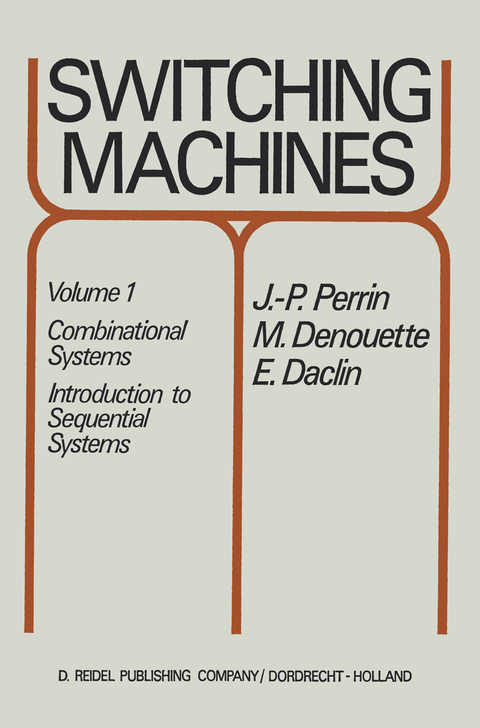
Switching Machines
Kluwer Academic Publishers (Verlag)
978-90-277-0196-1 (ISBN)
- Titel z.Zt. nicht lieferbar
- Versandkostenfrei
- Auch auf Rechnung
- Artikel merken
We shall begin this brief section with what we consider to be its objective. It will be followed by the main outline and then concluded by a few notes as to how this work should be used. Although logical systems have been manufactured for some time, the theory behind them is quite recent. Without going into historical digressions, we simply remark that the first comprehensive ideas on the application of Boolean algebra to logical systems appeared in the 1930's. These systems appeared in telephone exchanges and were realized with relays. It is only around 1955 that many articles and books trying to systematize the study of such automata, appeared. Since then, the theory has advanced regularly, but not in a way which satisfies those concerned with practical applications. What is serious, is that aside the books by Caldwell (which dates already from 1958), Marcus, and P. Naslin (in France), few works have been published which try to gather and unify results which can be used by the practis ing engineer; this is the objective of the present volumes.
1/Boolean Algebra.- 1.1. Introduction.- 1.2. Binary number systems—codes.- 1.3. Postulates and theorems of Boolean algebra.- 1.4. Boolean functions.- 1.5. Reduction of Boolean functions—Map representation.- 1.6. Reduction of Boolean functions (continued)—McCluskey-Quine method.- 1.7. Reduction of functions containing ‘don’t care’ terms.- 1.8. Factorization of Boolean functions.- 1.9. Conclusions.- Appendixes.- Exercises.- 2/Practical Realization of Logical Functions.- 2.1. Introduction.- 2.2. Elementary notions.- 2.3. The relay.- 2.4. Electronic circuits—Positive and negative logics.- 2.5. Diode circuits.- 2.6. Transistor circuits.- 2.7. Flip-flop and memory transistorized logics.- 2.8. Tunnel Diodes.- 2.9. Magnetic circuits.- 2.10. Cryotrons.- 2.11. Fluidic logic.- 2.12. Integrated circuits.- 2.13. Logical simulators.- Exercises.- 3/Combinational Systems.- 3.1. Introduction.- 3.2. Boolean algebra and technology.- 3.3. Combinational systems.- 3.4. Combinational dipoles.- 3.5. Study of combinational multipoles.- 3.6. Matrix analysis of combinational relay systems.- 3.7. Comparison between the general simplification method of Boolean functions and the matrix analysis method in relay systems.- Exercises.- 4/Introduction to Sequential Systems.- 4.1. Review of the general properties of transient phenomena in combinational Systems.- 4.2. Sequential systems—Analysis.- 4.2.5. Performance of a sequential system.- 4.3. Synthesis problems—Definitions of the internal state.- 4.4. Internal state—Technological state.- 4.5. Conclusion.- Appendix—Physical interpretation of the choice of internal variables.- Exercises.- 5/Representation and Classification of Sequential Systems.- 5.1. Introduction.- 5.2. Flow table of a sequential system.- 5.3. Asynchronous andsynchronous machines.- 5.4. Moore, Mealy, and Huffman machines.- 5.5. Complementary notions.- Exercises.- 6/Analysis of Sequential Systems Hazards in Sequential and Combinational Systems.- 6.1. Analysis of asynchronous sequential systems.- 6.2. Analysis of synchronous sequential systems.- 6.3. Hazards in combinational and sequential systems.- 6.4. Hazards in asynchronous sequential systems.- 6.5. Hazards in synchronous systems.- Exercises.
| Erscheint lt. Verlag | 30.6.1972 |
|---|---|
| Zusatzinfo | 416 p. |
| Verlagsort | Dordrecht |
| Sprache | englisch |
| Themenwelt | Mathematik / Informatik ► Informatik ► Theorie / Studium |
| ISBN-10 | 90-277-0196-2 / 9027701962 |
| ISBN-13 | 978-90-277-0196-1 / 9789027701961 |
| Zustand | Neuware |
| Haben Sie eine Frage zum Produkt? |
aus dem Bereich


